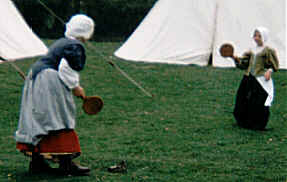
- The Siege group
- Home
- Who we are
- Living History
- On the Camp
- Costume
- 2007 Events
- News
- Membership info
- Picture Gallery
- Contact us
- Links
- Yahoo Group
- Site Credits
- The 17th Century
- Music
- Cookery
- Handicrafts
- Children
- Games
- Weaponry
- The Civil War
Children
Mothers in the baggage-trayne would have their children with them, so wherever the army went the children would always be present.
Because of this, their upbringing would be unconventional but these
were times of war and everyone would do their bit for their chosen cause.
In any case, a chance at life was better than the alternative. All too often, this was starvation, cold and almost certainly death, from disease or their enemies or from the very elements that surrounded them.
They had no choice but to stay with their mother and follow the drum. At least they had some shelter, however temporary, until the troubles were over.
Education
Both boys and girls were brought up strictly by their parents and elders. School was a luxury few could afford and an impossibility for the children of a travelling army.
On a long campaign the youngsters, especially the older ones, would learn skills and crafts from their parents or the other adults of the camp.
Toys
Toys play an important part in anyone's childhood and the children of the Civil War were no exception
Toys helped shape the way children saw the world that they
lived in, helping them to relate to all the things that happened to them
as they grew up in those years of conflict and war. Toys are also a  way
of helping children to grow up and develop a personality of their own.
way
of helping children to grow up and develop a personality of their own.
Boys would mostly be found outdoors playing with wooden swords, sticks and stones, fighting mock battles between themselves, mirroring the conflicts that they would have seen and heard about during their childhood years.
Girls on the other hand would stay at home and care for their young siblings, playing with small dolls and bits of material, pretending to be like the womenfolk in their life.
Only rich families could afford to buy ready-made toys for their children. Most children in poorer families made do with toys that could easily be carved out of wood or made with scraps of material, or they played with household items indoors.
Games
Many of the games played by children in the 17th century, such as Hopscotch, have survived in one form or another to the present day. You can still see children unknowingly keeping up a tradition in the playground or at village fetes etc.
Some games from the 17th century are described on our Games page. See how many you remember.